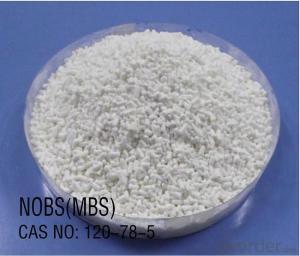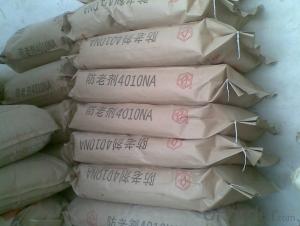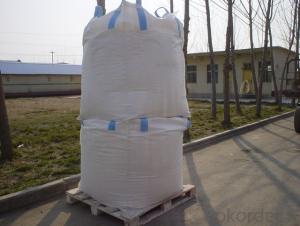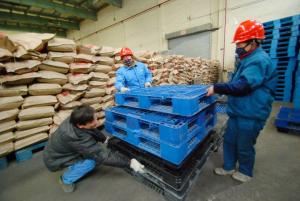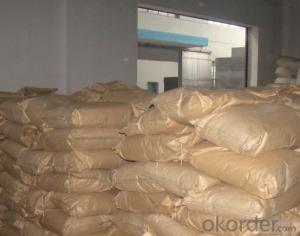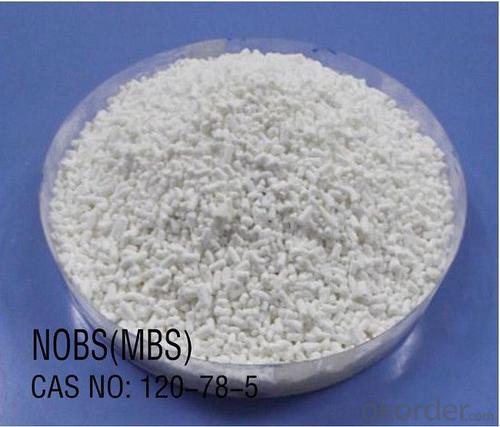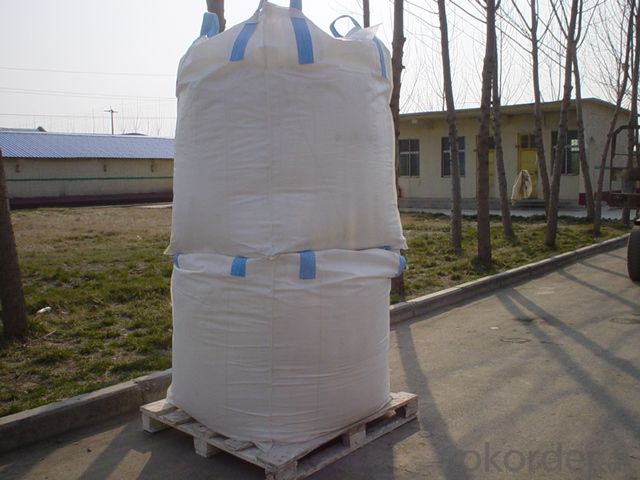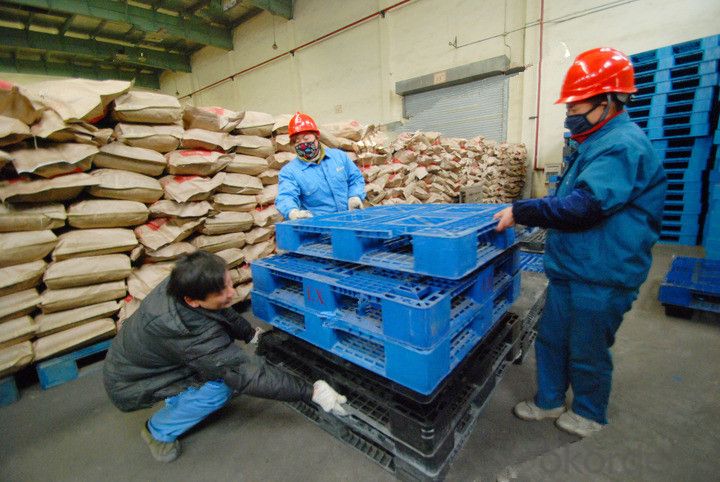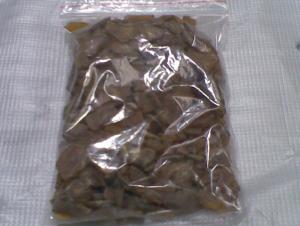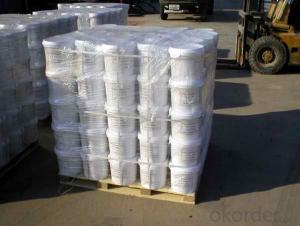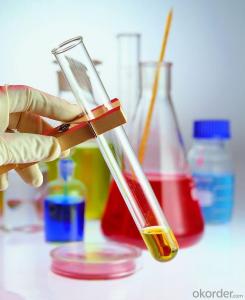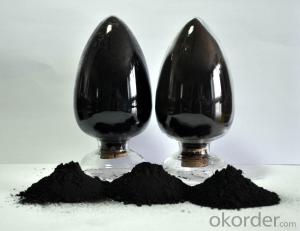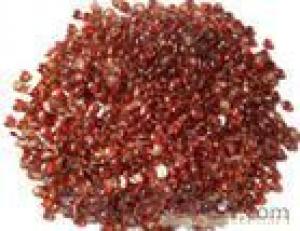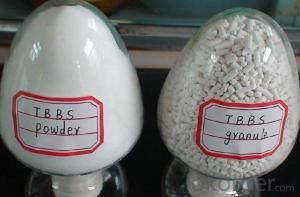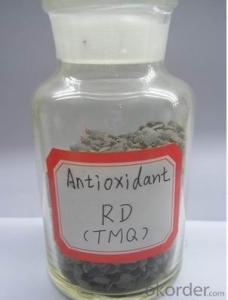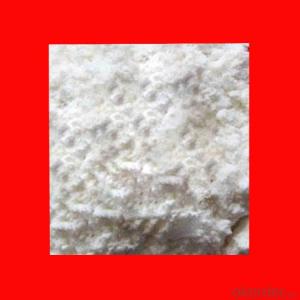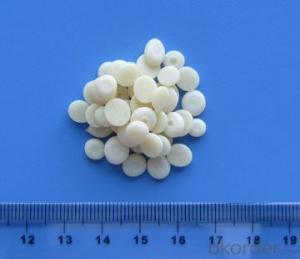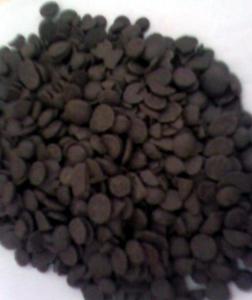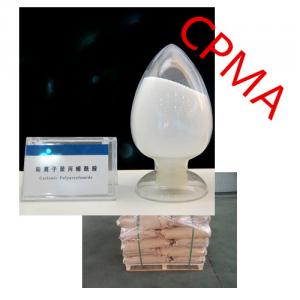Rubber Chemcials Rubber Antioxidant NDBC (NBC)
- Loading Port:
- Tianjin
- Payment Terms:
- TT OR LC
- Min Order Qty:
- 25 m.t.
- Supply Capability:
- 12000 m.t./month
OKorder Service Pledge
OKorder Financial Service
You Might Also Like
NDBC (NBC)
Chemical Name:Nickel Dibutyl Dithiocarbamate
Molecular Formula:C 18 H36 N 2 S 4 Ni
Molecular Weight:467
CAS No.:13927-77-0
Specifications:
Item
| Specifications
|
Appearance
| Dark-green Power (Granules)
|
Initial Melting Point, °C Min.
| 83
|
Heat Loss , % Max.
| 0.5 |
Nickel content , %
| 12.0 - 13.0
|
Residue on 150 µm Sieve , % Max.
| 0.10 |
Residue on 63 µm Sieve , % Max.
| 0.50 |
Properties: Dark-green Power. Density is 1.26g/ cm3 . flashing point is 260°C. Soluble in chloroform, benzene and carbon bisulfide , a little soluble in acetone, insoluble in water.
Applications: Mainly use in styrene- butadience rubber, chloroprene rubber and chlorosul-fonated polyethylene rubber. Avoiding the rubber crack for the sunshine and ozone, promoting the heat-resistant of chloroprene rubber and chlorosul-fonated polyethylene rubber. In plastic industry, it can be used as stabilitant and ozone-resistant agent for high polymer materials. It has advantage of stability for polypropylene fibre , thin film and narrow belt, but it will make the products appear yellow-green color. The use level is 0.3~0.5%. NDBC is regulated for use in articles in contact with food as specified.
Packing:Coextruded paper bags lined with polyethylene film bags. Net weight 25 kg per bag.
Storage:Store closed containers in a cool, dry, well-ventilated area. Avoid exposure to direct sunlight.
- Q: What is the principle of the catalyst? Why can change the rate of chemical reactions and their own without any change
- The principle of the catalyst: the catalyst is mainly by reducing the activation energy, so that the reaction is easy to carry out, so as to achieve the catalytic effect.
- Q: Like biological and industrial reations. Thanks.
- Reactions that have high Activation Energy need catalysts to speed up reactions. These reactions aren't spontaneous since the reactants do not have enough energy to overcome the activation energy barrier. Catalysts are compounds that speed up reactions by providing an alternative pathway for the reaction. It is a common misconception that catalysts lower the activation energy. It doesn't actually lower the activation energy, instead it provides an alternative pathway with lower activation energy. For example, breakdown of hydrogen peroxide happens in nature but, relatively slowly. When you add a little bit of manganese dioxide, the breakdown happens a lot faster. Another example is, breakdown of glucose in the body. It is facilitated by an enzyme called amylase (or carbohydrase). An industrial example is the use of vanadium pentoxide (V2O5) in the Contact process, where SO2 is converted to SO3 in the presence of V2O5. Hope that helps!
- Q: Is the reaction of the exhaust purification of cars (carbon monoxide and nitrogen
- NO + 2CO = 2CO2 + N2 reaction is exothermic. Conditional catalyst
- Q: What are the catalysts that appear in the chemistry experiment?
- Oxygen Oxygen Oxygen Oxygen also used when the catalyst is manganese dioxide MnO2
- Q: Why the catalyst is required to have a large surface area and a rich pore structure
- Chemical reactions are generally contact reaction, of course, the more contact with the faster response, pore structure is to increase the contact area
- Q: The role of catalyst in chemical reactions
- The role of the catalyst is to change the reaction required to achieve the activation energy, can reduce the activation energy is called positive catalyst (that is, usually the meaning of the catalyst), to improve the activation energy is negative catalyst
- Q: Will the catalyst in the chemical reaction be reduced?
- The amount of catalyst in the chemical reaction is not reduced, the catalyst is divided into a positive catalyst and a negative catalyst, the positive catalyst promotes the reaction, and the negative catalyst inhibits the reaction
- Q: I know that a species that does not appear in the chemical equation may also affect the rate of a reaction - e.g. a catalyst. But does that mean the catalyst can be present in the rate equation, and if so are catalysts always present in the rate equation?
- Yes, a catalyst can be included in a rate law. That's because, most reactions occur in a series of step and the rate is based on the rate determining step, which is the slowest step. A catalyst may be a reactant in the rate determining step, and a product in a subsequent step. Therefore, the catalyst is not included in the overall reaction. But a catalyst need not always be in the rate law. The rate law is usually based on the rate determining step. ========== Follow up =========== In the free response questions on the AP chemistry exam there has been at least one case where a rate law included a catalyst( 2002D). Brown and LeMay always include at least one in their examples, and I always cover this situation when I teach rate laws and mechanisms in AP chemistry. Here is one comment: Other examples of species not in the balanced reaction occurring in the rate law would include catalysis, where a catalyst does not normally appear in the balanced reaction but does appear in the rate law. www.chem.arizona.edu/~salzmanr/48... Consider this generalized reaction which is catalyzed by M A + B --C A + M --Q ... slow Q + B --C ... fast M is the catalyst, and Q is the intermediate. The slow, or rate determining step, depends only on the concentrations of A and M, the catalyst. So even though the overall reaction does not include, M, the rate law does. Rate = k[A][M]
- Q: Just something I've always wondered about...
- transition okorder /... for ex-- X (one reactant) + catalyst(transition element) ------X.catalyst(intermediate unstable compound) X.catalyst + Y (other reactant) --------XY(product) + catalyst how the change in oxidation state of transition elements helps the reacton through the formation of intermediates may be seen from reaction in between SO2 and O2 to form SO3 in presence of V2O5 ... V2O5 + SO2 ------V2O4 + SO3 2V2O4 + O2 ------2V2O5 in the above reaction vanadium changes its oxidation state from +5 to +4 and again to +5.. another example is reaction in between iodide and persulphate ions in presence of Fe(III) as catalyst... 2I(-) + S2O8(2-) ---------I2 + 2SO4(2-) (Fe(III) is present as catalyst) the reaction is believed to take place as follows: 2Fe(3+) + 2I(-) ------2Fe(2+) + I2 2Fe(2+) + S2O8(2-) ------2Fe(3+) + 2SO4(2-) (3)in number of cases transition elements provide a suitable large surface area with free valencies on which reactants are absorbed ...as a result concentration of reactants on surface of catalysts increases..hence rate of reaction increases...this is known as adsorption theory.... according to adsorption theory : there are free valencies on surface of solid transition metals because of the incomplete d-subshelll.. so the mechanism of catalysis involve followin five steps: (1) diffusion of reactant molecules towards surface of catalyst... (2) adsorption of reactant molecules on surface of catalyst by forming loose bonds with catalyst due to free valencies... (3)occurence of chemical reactions between reactant and catalyst forming an intermediate.. (4)desorption of product molecules from surface due to its lack of affinity for the catalyst surface thereby making the surface free for fresh adsorption of reactant molecules... (5)diffusion of product molecules away from surface of catalyst...
Send your message to us
Rubber Chemcials Rubber Antioxidant NDBC (NBC)
- Loading Port:
- Tianjin
- Payment Terms:
- TT OR LC
- Min Order Qty:
- 25 m.t.
- Supply Capability:
- 12000 m.t./month
OKorder Service Pledge
OKorder Financial Service
Similar products
Hot products
Hot Searches
Related keywords
